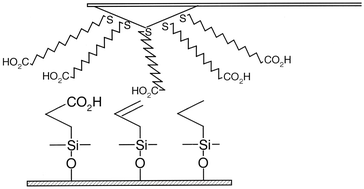Trichloroalkylsilanes readily form self-assembled monolayers (SAMs) on mica surfaces. The present work uses scanning probe methods (atomic force microscopy (AFM), chemical force microscopy (CFM) and nanoindentation) to study aspects of the assembly process and the properties of some short chain forms of these self-assembled monolayers. The deposition of propyltrichlorosilane (CH3CH2CH2SiCl3, PTS) and allyltrichlorosilane (H2C![[double bond, length as m-dash]](https://www.rsc.org/images/entities/char_e001.gif) CHCH2SiCl3, ATS) at varying temperatures (−78 °C to +25 °C) on mica substrates has been examined. The ATS films were subsequently modified by oxidation to form a –COOH terminated species. These films were characterized by chemical force microscopy using functionalized tips at varying pH values. In addition, nanoindentation was utilized to study the Young's modulus and hardness
of the films. We find that at low deposition temperatures, smooth overlayers of these short chain films are formed, without the formation of polymerised aggregates that are seen at higher temperatures. The surface ordering also appears to be higher under these conditions. The surface pKa of the oxidized ATS is larger than that of the longer chain analogue previously characterised by chemical force microscopy. Nanoindentation can readily distinguish between ordered and polymerised aggregates on the surface.
CHCH2SiCl3, ATS) at varying temperatures (−78 °C to +25 °C) on mica substrates has been examined. The ATS films were subsequently modified by oxidation to form a –COOH terminated species. These films were characterized by chemical force microscopy using functionalized tips at varying pH values. In addition, nanoindentation was utilized to study the Young's modulus and hardness
of the films. We find that at low deposition temperatures, smooth overlayers of these short chain films are formed, without the formation of polymerised aggregates that are seen at higher temperatures. The surface ordering also appears to be higher under these conditions. The surface pKa of the oxidized ATS is larger than that of the longer chain analogue previously characterised by chemical force microscopy. Nanoindentation can readily distinguish between ordered and polymerised aggregates on the surface.

You have access to this article
 Please wait while we load your content...
Something went wrong. Try again?
Please wait while we load your content...
Something went wrong. Try again?
![[double bond, length as m-dash]](https://www.rsc.org/images/entities/char_e001.gif) CHCH2SiCl3, ATS) at varying temperatures (−78 °C to +25 °C) on mica substrates has been examined. The ATS films were subsequently modified by
CHCH2SiCl3, ATS) at varying temperatures (−78 °C to +25 °C) on mica substrates has been examined. The ATS films were subsequently modified by 

 Please wait while we load your content...
Please wait while we load your content...